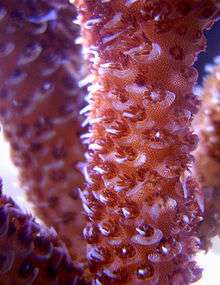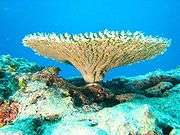Acropora
| Acropora | |
|---|---|
 | |
| Acropora pulchra | |
| Scientific classification | |
| Kingdom: | Animalia |
| Phylum: | Cnidaria |
| Class: | Anthozoa |
| Order: | Scleractinia |
| Family: | Acroporidae |
| Genus: | Acropora Oken, 1815[1] |
| Species | |
|
See text | |
Acropora is a genus of small polyp stony coral in the phylum Cnidaria.[2] Some of its species are known as table coral, elkhorn coral, and staghorn coral. Over 149 species are described.[3] Acropora species are some of the major reef corals responsible for building the immense calcium carbonate substructure that supports the thin living skin of a reef.
Anatomy and distribution

Depending on the species and location, Acropora species may grow as plates or slender or broad branches. Like other corals, Acropora corals are colonies of individual polyps, which are about 2 mm across and share tissue and a nerve net. The polyps can withdraw back into the coral in response to movement or disturbance by potential predators, but when undisturbed, they protrude slightly. The polyps typically extend further at night to help capture plankton and organic matter from the water.
Acropora is most common in shallow reef environments with bright light and moderate to high water motion. Many small reef fishes live near their colonies and retreat into the thicket of branches if threatened.
Threats

Symbiodinium, symbiotic algae, live in the corals' cells and produce energy for the animals through photosynthesis. Environmental destruction has led to a dwindling of populations of Acropora, along with other coral species. Acropora is especially susceptible to bleaching when stressed. Bleaching is due to the loss of the coral's zooxanthellae, which are a golden-brown color. Bleached corals are stark white and may die if new Symbiodinium cells cannot be assimilated. Common causes of bleaching and coral death include pollution, abnormally warm water temperatures, increased ocean acidification, sedimentation, and eutrophication.
As of November 13, 2014, the U.S. Fish and Wildlife Service has listed 10 Acropora species as Threatened. The species are distributed in the Indo-Pacific (8 species) and Caribbean (2 species).
Reef-keeping

Most Acropora species are brown or green, but a few are brightly colored, and those rare corals are prized by aquarists. Captive propagation of Acropora is widespread in the reef-keeping community. Given the right conditions, many Acropora species grow quickly, and individual colonies can exceed a meter across in the wild. In a well-maintained reef aquarium, finger-sized fragments can grow into medicine ball-sized colonies in one to two years. Captive specimens are steadily undergoing changes due to selection which enable them to thrive in the home aquarium. In some cases, fragments of captive specimens are used to repopulate barren reefs in the wild.[4]
Acropora species are challenging to keep in a home aquarium. They require bright light, stable temperatures, regular addition of calcium and alkalinity supplements, and clean, turbulent water.
Common parasites of colonies in reef aquariums are the Acropora-eating flatworm, and "red bugs" (Tegastes acroporanus).
Species

- Acropora abrolhosensis Veron, 1985
- Acropora abrotanoides (Lamarck, 1816)
- Acropora aculeus (Dana, 1846)
- Acropora acuminata (Verrill, 1864)
- Acropora akajimensis Veron, 1990
- Acropora anthocercis (Brook, 1893)
- Acropora arabensis Hodgson and Carpenter, 1996
- Acropora aspera (Dana, 1846)
- Acropora austera (Dana, 1846)
- Acropora awi Wallace and Wolstenholme, 1998
- Acropora azurea Veron and Wallace, 1984
- Acropora batunai Wallace, 1997
- Acropora bifurcata Nemenzo, 1971
- Acropora branchi Riegl, 1995
- Acropora brueggemanni (Brook, 1893) now classified as Isopora brueggemanni
- Acropora bushyensis Veron and Wallace, 1984
- Acropora cardenae Wells, 1986
- Acropora carduus (Dana, 1846)
- Acropora caroliniana Nemenzo, 1976
- Acropora cerealis (Dana, 1846)
- Acropora cervicornis (Lamarck, 1816) - staghorn coral
- Acropora chesterfieldensis Veron and Wallace, 1984
- Acropora clathrata (Brook, 1891)
- Acropora convexa
- Acropora cophodactyla (Brook, 1892)
- Acropora copiosa Nemenzo, 1967
- Acropora crassa (Milne-Edwards and Haime, 1860)
- Acropora crateriformis (Gardiner, 1898) now classified as Isopora crateriformis
- Acropora cuneata (Dana, 1846) now classified as Isopora cuneata
- Acropora cymbicyathus (Brook)
- Acropora cytherea (Dana, 1846)
- Acropora danai (Milne-Edwards and Haime, 1860)
- Acropora delicatula (Brook)
- Acropora dendrum (Bassett-Smith, 1890)
- Acropora derawaensis Wallace, 1997
- Acropora desalwii Wallace, 1994
- Acropora digitifera (Dana, 1846)
- Acropora divaricata (Dana, 1846)
- Acropora diversa (Brook)
- Acropora donei Veron and Wallace, 1984
- Acropora echinata (Dana, 1846)
- Acropora elegans (Milne-Edwards and Haime, 1860)
- Acropora elseyi (Brook, 1892)
- Acropora eurystoma (Klunzinger, 1879)
- Acropora exquisita Nemenzo, 1971
- Acropora florida (Dana, 1846)
- Acropora formosa (Dana, 1846)
- Acropora gemmifera (Brook, 1892)
- Acropora glauca (Brook, 1893)
- Acropora globiceps (Dana, 1846)
- Acropora grandis (Brook, 1892)
- Acropora granulosa (Milne-Edwards and Haime, 1860)
- Acropora halmaherae Wallace and Wolstenholme, 1998
- Acropora hemprichii (Ehrenberg, 1834)
- Acropora hoeksemai Wallace, 1997
- Acropora horrida (Dana, 1846)
- Acropora humilis (Dana, 1846)
- Acropora hyacinthus (Dana, 1846)
- Acropora indiana Wallace, 1994
- Acropora indonesia Wallace, 1997
- Acropora insignis Nemenzo, 1967
- Acropora intermedia (Brook, 1891)
- Acropora irregularis (Brook, 1892)
- Acropora jacquelineae Wallace, 1994
- Acropora kirstyae Veron and Wallace, 1984
- Acropora kosurini Wallace, 1994
- Acropora latistella (Brook, 1892)
- Acropora listeri (Brook, 1893)
- Acropora loisetteae Wallace, 1994
- Acropora lokani Wallace, 1994
- Acropora longicyathus (Milne-Edwards and Haime, 1860)
- Acropora loripes (Brook, 1892)
- Acropora lovelli Veron and Wallace, 1984
- Acropora lutkeni Crossland, 1952
- Acropora magnifica Nemenzo, 1971
- Acropora microclados (Ehrenberg, 1834)
- Acropora microphthalma (Verrill, 1869)
- Acropora millepora (Ehrenberg, 1834)
- Acropora mirabilis Quelch, 1886
- Acropora monticulosa (Brueggemann, 1879)
- Acropora mossambica Riegl, 1995
- Acropora multiacuta Nemenzo, 1967
- Acropora nana (Studer, 1878)
- Acropora nasuta (Dana, 1846)
- Acropora natalensis Riegl, 1995
- Acropora nobilis (Dana, 1846)
- Acropora ocellata (Klunzinger, 1879)
- Acropora palifera (Lamarck, 1816) now classified as Isopora palifera
- Acropora palmata (Lamarck, 1816) - elkhorn coral
- Acropora palmerae Wells, 1954
- Acropora paniculata Verrill, 1902
- Acropora parilis Quelch, 1886
- Acropora pharaonis (Milne-Edwards and Haime, 1860)
- Acropora plumosa Wallace and Wolstenholme, 1998
- Acropora pocilloporina Wallace, 1994
- Acropora polystoma (Brook, 1891)
- Acropora prolifera (Lamarck, 1816) - fused staghorn coral
- Acropora pruinosa (Brook, 1893)
- Acropora pulchra (Brook, 1891)
- Acropora rambleri Bassett-Smith, 1890
- Acropora reticulata (Brook, 1893)
- Acropora robusta (Dana, 1846)
- Acropora rosaria (Dana, 1846)
- Acropora rudis (Rehberg, 1892)
- Acropora russelli Wallace, 1994
- Acropora sabulata (Dana, 1846)
- Acropora samoensis (Brook, 1891)
- Acropora sarmentosa (Brook, 1892)
- Acropora schmitti Wells, 1950
- Acropora secale (Studer, 1878)
- Acropora sekiseiensis Veron, 1990
- Acropora selago (Studer, 1878)
- Acropora simplex Wallace and Wolstenholme, 1998
- Acropora solitaryensis Veron and Wallace, 1984
- Acropora sordiensis Riegl, 1995
- Acropora spicifera (Dana, 1846)
- Acropora splendida Nemonzo
- Acropora squarrosa (Ehrenberg, 1834)
- Acropora stoddarti Pillai and Scheer, 1976
- Acropora striata (Verrill, 1866)
- Acropora subglabra (Brook, 1891)
- Acropora subulata (Dana, 1846)
- Acropora suharsonoi Wallace, 1994
- Acropora sukarnoi Wallace, 1997
- Acropora surculosa (Dana, 1846)
- Acropora tanegashimensi -s Veron, 1990
- Acropora tenella (Brook, 1892)
- Acropora tenuis (Dana, 1846)
- Acropora teres (Verrill, 1866)
- Acropora togianensis Wallace, 1997 now classified as Isopora togianensis
- Acropora torihalimeda Wallace, 1994
- Acropora tortuosa (Dana, 1846)
- Acropora tumida Verrill, 1866
- Acropora turaki Wallace, 1994
- Acropora valenciennesi (Milne-Edwards and Haime, 1860)
- Acropora valida (Dana, 1846)
- Acropora variabilis (Klunzinger, 1879)
- Acropora vaughani Wells, 1954
- Acropora vennoveter Venson and Veterline, 2007
- Acropora verweyi Veron and Wallace, 1984
- Acropora wallacea Veron, 1990
- Acropora willisae Veron and Wallace, 1984
- Acropora yongei Veron and Wallace, 1984
References
- ↑ WoRMS (2010). "Acropora Oken, 1815". World Register of Marine Species. Retrieved 2012-02-10.
- ↑ "Acropora". Integrated Taxonomic Information System.
- ↑ Acropora at Encyclopedia of Life
- ↑ "Restoration". The Global Coral Repository. 2011.
Further reading
- Reyes-Bermudez A. et al. 2009. Differential expression of three galaxin-related genes during settlement and metamorphosis in the scleractinian coral Acropora millepora. BMC Evolutionary Biology 2009, 9:178. doi:10.1186/1471-2148-9-178
- Shinzato, C., Shoguchi, E., Kawashima, T., Hamada, M., Hisata, K., Tanaka, M., Fujie, M., et al. 2011. Using the Acropora digitifera genome to understand coral responses to environmental change. Nature, advance online publication. doi:10.1038/nature10249
External links
| Wikispecies has information related to: Acropora |
| Wikimedia Commons has media related to Acropora. |
